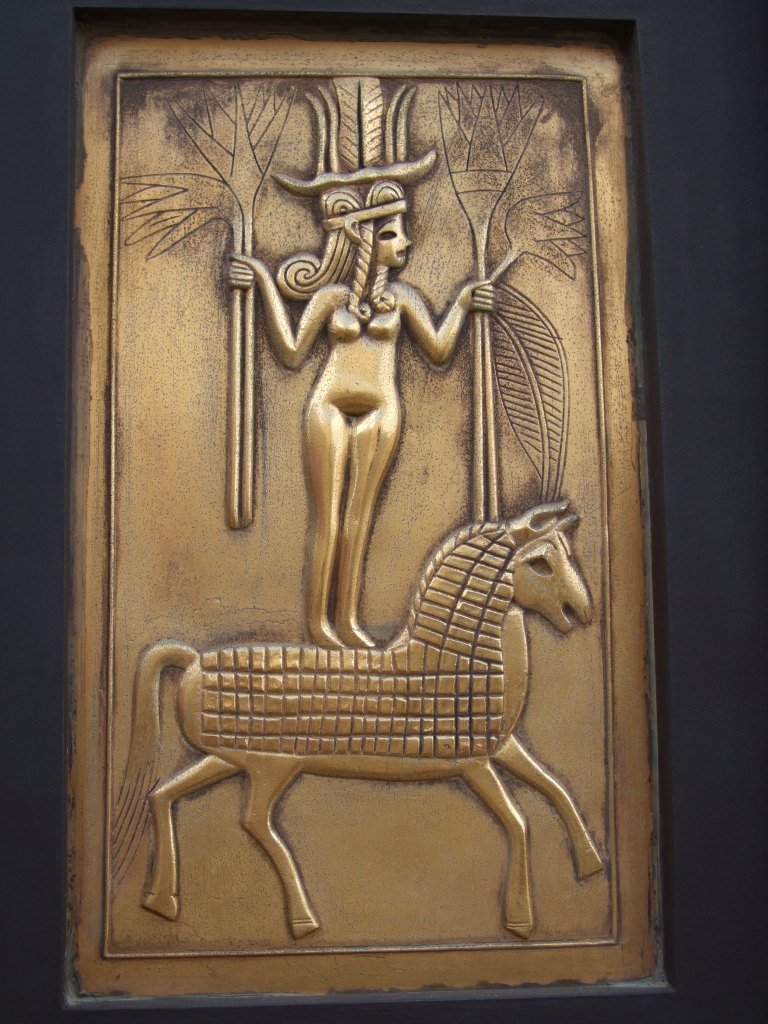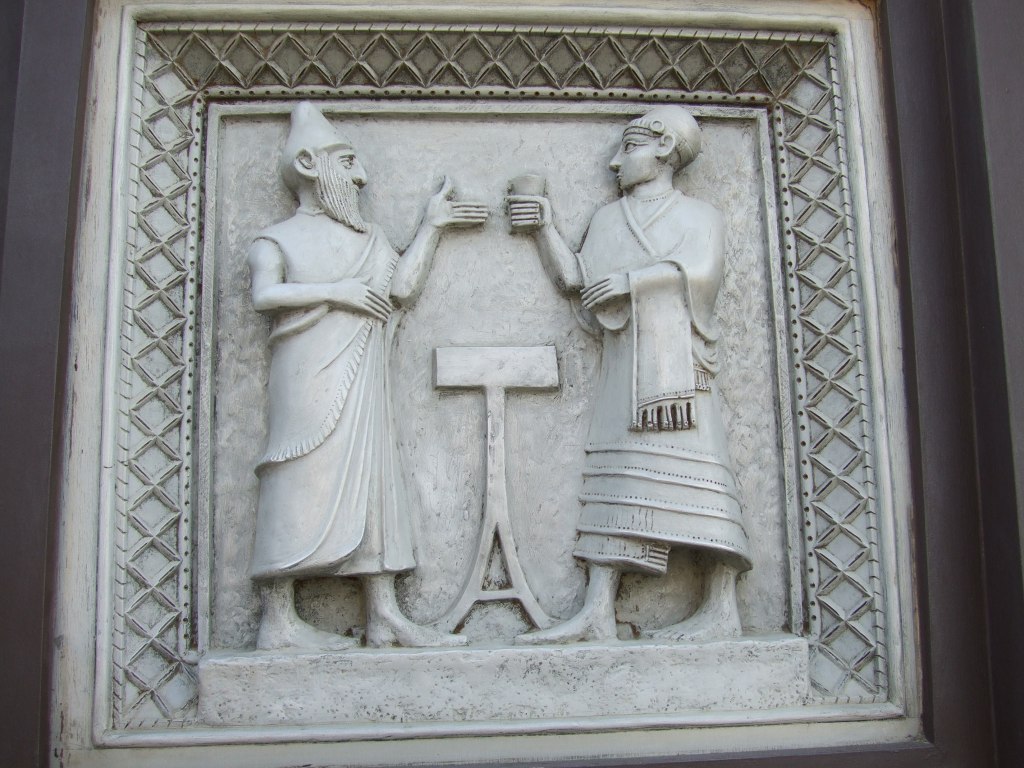ֹLocated at the entrance of the Jaffa Gate in Jerusalem, the Tower of David contains a highly recommended museum. Deploying a variety of illustrations, the museum narrates the transformation of Jerusalem from the Canaanite period (around 3200 BCE) to the time of the establishment of of the State of Israel (1948). What I have written below is cited and modified from the official website of the Tower of David Museum and from the explanatory placards during my visit of the museum in September 2008. All photos (unless otherwise stated) were taken by me.

1. Canaanite Period (3200 BCE)
On the basis of one Egyptian Curse on Jerusalem (19th century BCE) and several clay tablets discovered from the Egyptian royal archive of Tel Al Amarna (14th century BCE), the earliest available names of Jerusalem seem to be Rusalimum and Urusalim, a Canaanite region under the patronage of the Egyptian pharaohs.



2. First Temple Period (1006 BCE)
According to the Hebrew Bible/Old Testament, King David “went to Jerusalem against the Jebusites, the inhabitants of the land” and “captured the stronghold of Zion, that is the city of David” (2 Samuel 5:6-10). His son and successor, Solomon, built the great First Temple (1 Kings 6:1-38).
Let me pause here for a moment and interpose one archaeological reference to David, which I found to be on display in the Israel Museum:

The Babylonian king Nebuchadnezzar came and destroyed the First Temple in 586 BCE. Most of the Jews were then exiled to Babylon. Beginning with the line “By the rivers of Babylon, there we sat down and wept, when we remembered Zion,” Psalm 137 laments over the traumatic experience of the captivity. Interestingly, the experience “by the river Chebar among the exiles” also allowed Ezekiel, a prophet of priestly descent, to encounter the glorious visions of God (Ezekiel 1:1).

The unforgettable exile to Babylon is also retold beautifully and melancholically in the highly acclaimed Night Spectacular Show in the Tower of David. When night dawns, the walls of the Tower of David become the backdrop where the stories of Jerusalem come alive via a variety of visual and auditory wizardry. I have watched the show and will highly recommend it to anyone interested in the history of Jerusalem. For a preview, you can watch this official video on youtube:
3. Second Temple Period (515 BCE)
When the Persians overthrew the Babylonian empire in 538 BCE, Cyrus the conqueror allowed the Jews to return and reconstruct the Second Temple, which was completed in 515 BCE. According to the biblical account, Cyrus issued an edict:
Thus says Cyrus king of Persia, “The Lord, the God of heaven, has given me all the kingdoms of the earth, and He has appointed me to build Him a house in Jerusalem, which is in Judah. Whoever there is among you of all His people, may his God be with him! Let him go up to Jerusalem which is in Judah, and rebuild the house of the Lord, the God of Israel; He is the God who is in Jerusalem. And every survivor, at whatever place he may live, let the men of that place support him with silver and gold, with goods and cattle, together with a freewill offering for the house of God which is in Jerusalem” (Ezra 1:2-4; cf. 6:2-5; 2 Chronicles 36:22-23).
In the Tower of David Museum, we have a replica of the Cyrus cylinder (the original is kept in the British Museum and is dated to around 538 BCE), which seems to confirm the rather open and benevolent attitude of Cyrus towards his varied foreign captives. Speaking of the Mesopotamia, Cyrus in the cuneiform cylinder declared:

… I returned the (images of) the gods to the sacred centers [on the other side of] the Tigris whose sanctuaries had been abandoned for a long time, and I let them dwell in eternal abodes. I gathered all their inhabitants and returned (to them) their dwellings. In addition, at the command of Marduk, the great lord, I settled in their habitations, in pleasing abodes, the gods of Sumer and Akkad, whom Nabonidus, to the anger of the lord of the gods, had brought into Babylon (cited in COS 2:315)
Subsequent years witnessed the rise of the Hellenistic power (332 BCE), the revolt of the Maccabees (167-160 BCE), the reign of the Hasmoneans (140-40 BCE), and the march of the Romans into Jerusalem (63 BCE). Hostility had raged on between the Jews and the Romans under the rule of a series of procurators, until it came to a head in 70 CE, when the Jewish revolt led to the destruction of the Second Temple. The blazing desire for an independent Jewish state persisted even after then, and culminated in the Bar Kochba revolt (132-135 CE). This time, the Jews were banished from Jerusalem. The Emperor Hadrian razed the city and rebuilt it as Aelia Capitolina.

4. Byzantine Period (324 CE)
Christianity became the official religion of the Roman Empire. St Helena, mother of the Emperor Constantine, visited Jerusalem in 326 CE, identified many sites as the Christian holy places, and sparked a prodigious amount of the building of churches and basilicas on these sites. One of the most notable outcomes of this building campaign is the Church of the Holy Sepulchre, which remains a popular attraction to many Christian pilgrims.

The church compound is believed to contain sites where Jesus was crucified, buried and resurrected. Different Christian communities (the Greek Orthodoxy, the Franciscans, the Armenian Apostolic Church) strictly regulate their own usage of the common areas inside the church. Most interesting is the church’s enforcement of the Status Quo, under which, according to the Wikipedia, “no part of what is designated as common territory may be so much as rearranged without consent from all communities. This often leads to the neglect of badly needed repairs when the communities cannot come to an agreement among themselves about the final shape of a project.” Since none of the communities controls the main entrance, two Muslim families have been entrusted to hold the keys of the church, a tradition that can be traced back to 1187. You can check out the story of the key here. If you look closely at the photo taken above, you will observe a ladder standing on the cornice in front of a window. This famed “immovable ladder” testifies to another insteresting case generated by the Status Quo within the church. For the history of this ladder, check out this comprehensive article here.
5. My brain became so overwhelmed with the information absorbed at this point of my visit that I did not take any more pictures during my tour of the other corners of the museum, which displayed the history of Jerusalem in the Muslim Period (638 BCE), the Crusader Period (1099 CE), the Ayyubid Period (1187 CE), the Mamluk Period (1260 CE), the Ottoman Period (1517 CE) and the British rule (1917 CE). Luckily, brief summaries of the periods can be found in the official website of the Tower of David Museum. So I won’t repeat them here again. The only thing I wish to point out is that Jerusalem in modern Arabic is called al-Quds, a name derived from Bayt al-Maqdis, Bayt al-Muqaddas (בית המקדשׁ in Hebrew, “The House of the Holy” in English) that can be traced to the 9th century CE.
Having gone through all these stories of Jerusalem from different historical periods, I am reminded of one playful poem of Yehuda Amichai:
העיר משׂחקת מחבואים בין שׁמותיה
ירושׁלים, אל־קודס, שׁלם, גˊרו, ירו
לוחשׁת: יבוס, יבוס, יבוס, בחשׁכה
בוכה בגעגועים: אליה קפיטולינה, אליה, אליה
היא באה אל כל אחד הקורא לה בלילה לבדו.
אך אנו יודעים מי בא אל מי
The city plays hide-and-seek among her names:
Yerushalayim, al-Quds, Salem, Jeru, Yeru,
Whispering [her first, Jebusite name]: Yevus, Yevus, Yevus, in the dark.
She weeps with longing: Aelia Capitolina, Aelia, Aelia.
She comes to anyone who calls her at night, alone.
But we know who comes to whom.
Last Updated: 17th June 2017

Leave a comment